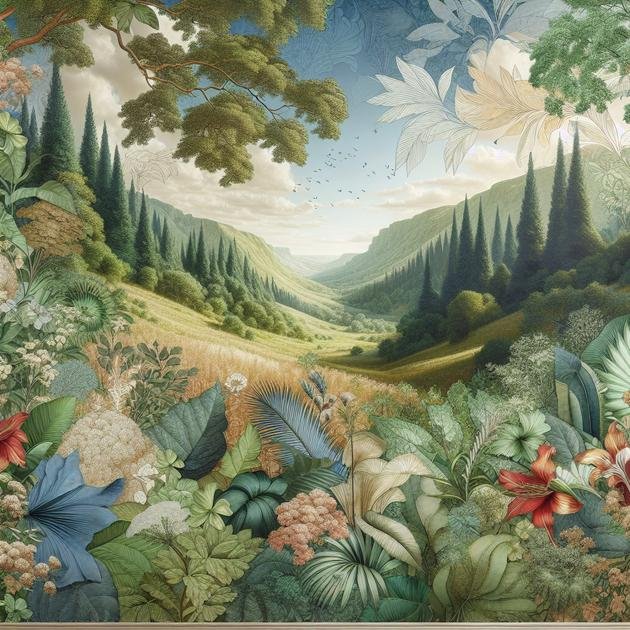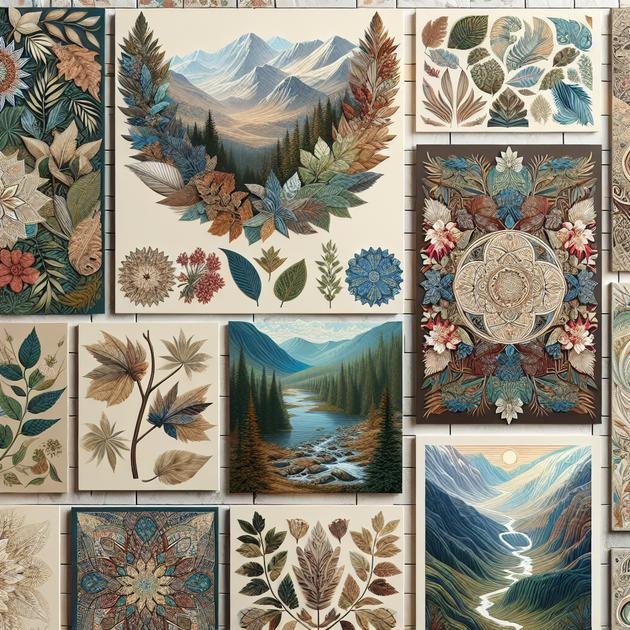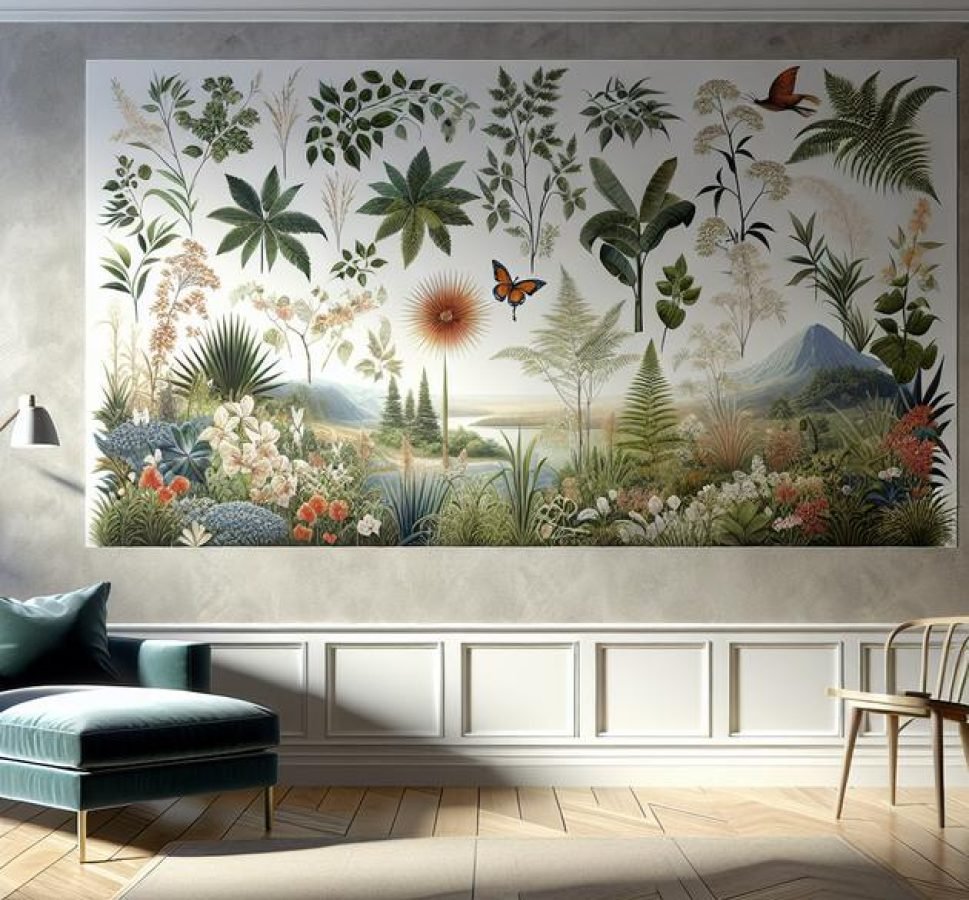Nature wall art brings the beauty of the outdoors inside, using elements like botanical prints, natural textures, and earthy tones to create serene, eco-friendly environments that reflect personal style and enhance any living space.
Ever thought about how nature wall art could transform your living space? Let’s explore how these ideas bring the outdoors inside.
choosing materials that mimic natural textures
Incorporating materials that mimic natural textures into your wall art can create a serene and grounded atmosphere in your space. Consider using materials like faux wood panels or peel-and-stick stone tiles that replicate the look and feel of real wood and stone without the cost or complexity of installation. These options are not only budget-friendly but also offer a quick way to refresh your walls.
Another great choice is using textured wallpapers that mimic the appearance of materials such as brick, suede, or grasscloth. These can add depth and visual interest to a room, creating a cozy and inviting environment. Additionally, there are eco-friendly options available that utilize recycled materials, providing a sustainable choice for environmentally conscious decorators.
Durable and Versatile Choices
Look for products that are durable and versatile. Materials like cork tiles not only add a natural texture but also serve as functional pinboards for notes or artwork. Similarly, using reclaimed barn wood or driftwood can add a rustic charm that complements various interior styles, from modern to traditional. Incorporating these elements will ensure your nature-inspired theme remains timeless and adaptable to changing decor trends.
incorporating botanical prints and patterns

Enhancing your home decor with botanical prints and patterns is a fantastic way to infuse nature’s beauty into your space. These prints can take various forms, from large-scale wall art depicting lush forests to smaller accents like pillows or curtains with floral motifs. By integrating these elements, you create a vibrant and dynamic environment that echoes the serenity of the outdoors.
Explore different styles to match your decor theme. For a minimalist touch, consider monochrome prints of leaves or ferns, which offer a subtle yet elegant look. If you’re leaning towards a more vivacious style, choose brightly colored floral patterns that can serve as the focal point in a room. Mixing and matching different botanical prints can also add depth and interest, particularly when layered with various textures and materials.
Creative Placement
Think creatively about where to place these patterns. An accent wall with a large mural of palm leaves can transport you to a tropical paradise, while a series of framed prints above a sofa can bring seasonal changes indoors. Whether it’s a gallery wall or a singular statement piece, botanical prints offer versatility and can easily fit into various home aesthetics, from rustic to contemporary.
utilizing color palettes inspired by nature
Using color palettes inspired by nature can transform a room into a soothing retreat. Start by incorporating shades that reflect natural elements, such as the blues of the ocean, the greens of the forest, or the earthy tones of a desert landscape. These hues can evoke a sense of tranquility and balance, making them perfect for spaces meant for relaxation, like living rooms or bedrooms.
Consider using a monochromatic color scheme for a minimalist and cohesive look. A range of green shades, for instance, can be layered from sage to deep forest, creating depth without overwhelming the senses. Alternatively, combining contrasting natural colors, like rust with deep navy or mustard with olive, can add vibrancy and energy to any space.
Accent and Harmony
Adding accents in natural colors is another effective way to bring the theme around full circle. Think about pillows, throws, and art pieces that complement the main palette. These accent items can introduce slight variances in color, adding interest and texture while maintaining harmony. Through strategic use of nature-inspired colors, your living space can become a reflection of the beauty and diversity found in the great outdoors.
crafting with natural elements and sustainable materials

Incorporating natural elements and sustainable materials into your art projects can not only enhance visual appeal but also benefit the environment. Embrace materials like reclaimed wood, stones, and dried botanicals to create unique and eco-friendly pieces. These elements offer rich textures and natural colors that can make any art piece stand out.
Consider using recycled metals or glass to create stunning installations or sculptures. These materials can add an industrial touch while keeping sustainability in mind. Bamboo is another excellent choice due to its fast-growing nature and versatile uses. It can be shaped into various forms, from frame borders to intricate patterns, lending an organic feel to your artwork.
Creative Techniques
Experimentation with natural dyes derived from plants and minerals can bring vivid colors to your creations without utilizing harmful chemicals. This approach not only helps in achieving a more authentic aesthetic but also supports eco-friendly practices. Whether you’re crafting wall hangings, home decor pieces, or sculptures, using sustainable resources provides a deeper connection to nature and showcases your commitment to the planet.
creating mood with lighting and earthy tones
Enhancing the atmosphere of a room through lighting and earthy tones can establish an inviting and calming environment. Start by selecting warm, soft lighting that diffuses softly across the space, creating a cozy and intimate mood. Lighting fixtures made from natural materials like rattan or bamboo can add an organic feel, blending seamlessly with other natural elements.
Incorporating earthy tones such as terracotta, muted greens, and soft browns enhances the warmth and connection to nature. These colors can be used on walls, rugs, or accent pieces to evoke the tranquility of the outdoors. Mixing various textures such as woven fabrics, leather, and wood can further enrich the space, making it feel snug and harmonious.
Balance and Harmony
Arrange your furniture and decor to make the best use of the lighting and color palette. Placing mirrors strategically can reflect light and make rooms feel larger and brighter. Earthy tones work well together, and when paired with the proper lighting, can instantly transform any room into a serene haven.
mixing and matching contemporary and rustic styles

Blending contemporary and rustic styles can create a unique and inviting atmosphere. Start by combining sleek, modern furniture with rustic elements like a reclaimed wood coffee table or vintage accessories. This mix adds character and warmth to any space, blending the old with the new in a harmonious manner.
To achieve balance, consider using a neutral color palette with pops of bold colors in contemporary art or throw pillows. Mixing textures is also key; pair smooth surfaces like glass and metal with rougher materials such as stone or raw wood. This approach ensures that the space feels curated and cohesive rather than cluttered.
Decorative Elements
For a touch of creativity, combine rustic pieces like an aged leather armchair with a modern sofa. Accessorize with items that showcase both styles, such as a modern lamp with a rustic base. This fusion can be both functional and aesthetically pleasing, offering a unique style that reflects personal taste while maintaining an effortless charm.
Conteúdo não disponível





